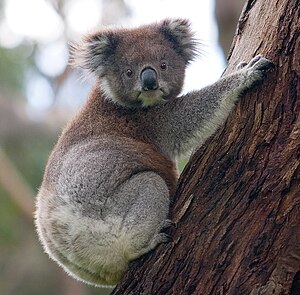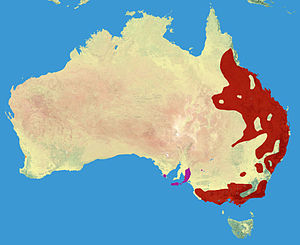Koala - Phascolarctos cinereus: Difference between revisions
No edit summary |
m (Animal moved page Koala (Phascolarctos cinereus) to Koala - Phascolarctos cinereus over redirect) |
||
| (One intermediate revision by the same user not shown) | |||
Latest revision as of 16:01, 28 March 2024

The koala (Phascolarctos cinereus) or, sometimes inaccurately called, koala bear, is an arboreal herbivorous marsupial native to Australia. It is the only extant representative of the family Phascolarctidae and its closest living relatives are the wombats.
The koala is found in coastal areas of the mainland's eastern and southern regions, inhabiting Queensland, New South Wales, Victoria, and South Australia.

Koalas typically inhabit open eucalyptus woodland, as the leaves of these trees make up most of their diet. This eucalypt diet has low nutritional and caloric content and contains toxins that deter most other mammals from feeding on it. Koalas are largely sedentary and sleep up to twenty hours a day. They are asocial animals, and bonding exists only between mothers and dependent offspring. Adult males communicate with loud bellows that intimidate rivals and attract mates. Males mark their presence with secretions from scent glands located on their chests. Being marsupials, koalas give birth to underdeveloped young that crawl into their mothers' pouches, where they stay for the first six to seven months of their lives. These young koalas, known as joeys, are fully weaned around a year old. Koalas have few natural predators and parasites, but are threatened by various pathogens, such as Chlamydiaceae bacteria and koala retrovirus.
Basic description
Koalas are marsupials that live in Australia. They have dense fur, round bodies, fluffy ears, and large oval-shaped noses. Their fur is usually grey or grey-brown in colour, and their undersides are lighter than their backs.
Scientific name
Genus: Phascolarcto – phaskolos meaning pouched; arktos meaning bear (derived from Greek).[1]
Species: cinereus meaning ashy-grey (derived from Latin).[1]
Etymology
The word koala is said to come from the Dharug peoples (whose traditional lands span the area from Parramatta to the Blue Mountains of New South Wales) word meaning ‘no water’. In South East Queensland, koalas are called dumbirrbi in the Jagera language, marrambi in the Yugarabul language, borobi in the Ugambeh language, and dumbribbi in the Turrbul language.[1]
Anatomy
The koala is easily recognisable by its stout, tailless body and large head with round, fluffy ears and large, spoon-shaped nose. The koala has a body length of 60–85 cm (24–33 in) and weighs 4–15 kg (9–33 lb). Fur colour ranges from silver grey to chocolate brown.
Koalas from the northern populations are typically smaller and lighter in colour than their counterparts further south. These populations possibly are separate subspecies, but this is disputed.
Threats to the koala population
The koala has suffered dramatic population declines as a result of habitat loss and fragmentation, disease, vehicle collision mortality, dog attacks, bushfires and climate change. In 2012, koalas were officially declared vulnerable by the Australian government and listed as a threatened species.
On February 12, 2022, the koala was officially listed as endangered in the Australian Capital Territory, New South Wales, and Queensland.[2]
Habitat loss
Habitat loss is one of the biggest threats to koalas. Since Europeans first settled in Australia in 1788, Australia’s eucalyptus forests have been vanishing at an alarming rate. More than four fifths of original Koala habitat has been destroyed.[3] Clearing of the land for expansion of human settlement, for example, for agriculture, housing, mining, forestry, shops, factories and roads is the main cause of habitat loss.[3]
In South East Queensland, the human population is increasing by more than 1000 people a week. This rapid population growth and increased need for houses is placing considerable pressure on the limited remaining koala habitat.[4] As habitat patches become smaller and more fragmented, koalas are more likely to move through developed areas.
Vehicle collision mortality
As habitat loss pushes koalas towards urban areas vehicle collisions become an increasing threat to koalas. According to the the Department of Environment and Heritage Protection in Queensland, Australia, more than 85% of koalas hit by a car die.[5]
Koalas are particularly vulnerable to vehicle collisions because they are slow-moving animals and often cross roads at night when they are difficult to see.[5] The risk of hitting a koala may be reduced by driving more slowly and scanning the roadsides for signs of movement—or by trying to avoid driving in areas where koalas occur at those times when they are most active.[5]
Efforts being made to reduce the number of vehicle collisions involving koalas include implementing speed limits and warning signs in areas where koalas are known to cross roads.
Dog attacks
It is estimated that 300 koalas die each year in south-east Queensland alone as a result of dog attacks, making it the third most common cause of death after habitat clearing and vehicle strikes.[6] A survey of dog attacks in south-east Queensland has identified the key elements of the issue.[7]
- Most attacks on koalas take place in the dog’s own backyard.
- Not all dogs attack koalas.
- Ninety-six percent of attacks on koalas were by dogs over 10kg. Generally, the larger the dog, the greater the likelihood that it could be responsible for a fatal attack on a koala.
- Although dog attacks occur throughout the year, they are more likely to occur between July and September (peaking in September). This is when koalas are breeding and therefore more mobile.
- If there are two or more dogs present at a property there is a higher incidence of attack.
- Attacks on sick koalas are no more frequent than for healthy ones.
Chlamydia
Chlamydia is a bacterial infection that affects both humans and animals, including koalas. In koalas, it can cause conjunctivitis (eye inflammation), leading to blindness, bladder infections, and infertility due to cysts in the reproductive tract.[8] It is spread through contact between individuals or contaminated food sources such as pap (a eucalyptus leaf).[8]
Chlamydia in koalas is caused by two kinds of bacteria, Chlamydia pecorum and C. pneumoniae, which are different from the bacteria that usually causes the disease in humans. However, the latter could theoretically make humans sick if an infected koala urinates on them.[9]
Surveys have shown that some wild populations demonstrate a 100 percent rate of infection,[10] which frequently leads to blindness, severe bladder inflammation, infertility and death. And treatment with antibiotics could create further problems for the marsupials, upsetting their gut microbes and making it difficult for them to digest the eucalyptus leaves that are a staple of their diet.
Another study investigated the prevalence of Chlamydia pecorum infection and disease in 160 koalas in a peri-urban wild population in Queensland, Australia and found that 31% of koalas were Chlamydia PCR positive and 28% had clinically detectable chlamydial disease.[11]
Vaccination programmes
| This page forms part of Project Species and considered an phase 2 article (started but not complete). Please consider adding more knowledge to this page. See Project Species for more information. |
See also
External links
- Koala Wikipedia
- Australian Koala Foundation
References
- ↑ 1.0 1.1 1.2 Archived: Koala facts The Department of Environment and Science, Queensland
- ↑ Archived: Koala listing under national environmental law Department of Climate Change, Energy, the Environment and Water
- ↑ 3.0 3.1 Archived:Threats To The Koala Australian Koala Foundation
- ↑ Archived: Koala threats and how to help Queensland Government
- ↑ 5.0 5.1 5.2 Living with Wildlife - Koalas Department of Environment and Heritage Protection
- ↑ http://wildcare.org.au/Documents/Koalas_and_dogs.pdf
- ↑ http://wildcare.org.au/Documents/Koalas_and_dogs.pdf
- ↑ 8.0 8.1 Koala Chlamydia STD Check (cannot be archived)
- ↑ Archived:Australia Begins Vaccinating Hundreds of Koalas Against Chlamydia in New Trial Smithsonian Magazine
- ↑ Archived: Why the Heck Do So Many Koalas Have Chlamydia? Live Science
- ↑ Archived: Epidemiology of chlamydial infection and disease in a free-ranging koala (Phascolarctos cinereus) population Plos One
